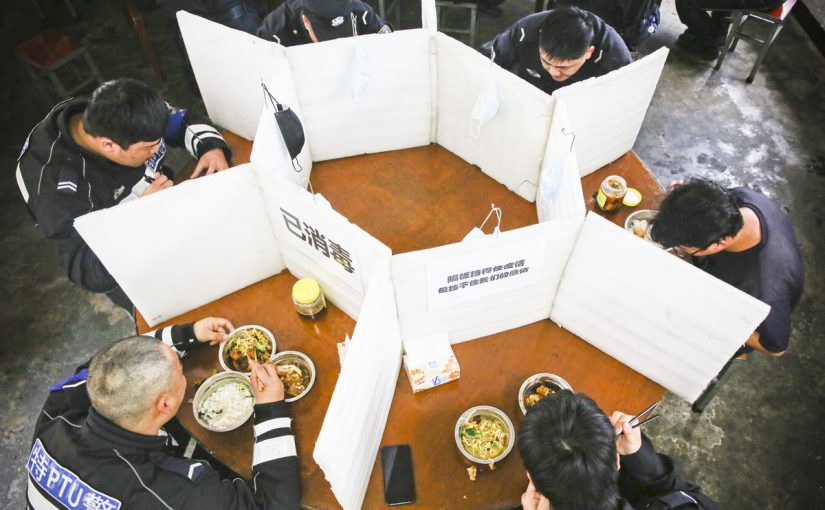DINING: The restaurants in Singapore have created special round tables with partitions for their customers to enjoy their dinners.
By Chew Hui Min
The tiny former British colony Singapore which is now a major trading and finance hub beat back Covid-19 with its traditional discipline in enforcing rules on wearing masks and maintaining physical distance…….
Singapore was one of the first countries in Asia to see COVID-19 cases back in January, when very little was known about the disease, and it was one of the first places where there was community spread.
Nine months on, the country has recorded more than 57,000 COVID-19 cases, but this is a fraction of the tens of millions of infections around the world.
So far, 28 people have died of COVID-19 in Singapore – one of the lowest mortality rates in the world. In the US, where there have been about 8 million cases, more than 200,000 people have died.
As of Saturday (Oct 17), 37 COVID-19 patients remain hospitalised in Singapore, with none in intensive care. More than 99 per cent of those infected have been discharged, while there are 41 in community care facilities.
But it wasn’t always like this. Three National Centre for Infectious Diseases (NCID) consultants told CNA how treatment of the novel coronavirus has evolved here and how NCID has kept the number of critical cases low.
The initial stages of the outbreak were fraught with uncertainty, said Dr Ray Lin Junhao, 37, an infectious disease consultant at Tan Tock Seng Hospital and NCID.
He was involved in the direct care of COVID-19 patients, including those who were critically ill. Dr Lin was also a co-investigator in several clinical trials that evaluated therapeutics for the disease.
“With the advances in research over the past few months, we now have a better idea of what treatment works and what doesn’t. Although the efficacy of the currently available treatment is modest, at least we are no longer groping in the dark,” said Dr Lin.
“CONSTANT STRUGGLE”
One of the differences between the COVID-19 pandemic and previous outbreaks has been the vast amount of information about the coronavirus on the Internet and social media, available to both doctors and the general public.
This has influenced the course of the current pandemic, he said. In the early days of the outbreak, reports of potential treatments for COVID-19 made it “tempting” to use them on the sickest patients, he added.
“As a physician, it is in our nature to want to give some form of treatment to our patients, even if unproven, rather than to stand by passively and hope for the best … This was a constant struggle in the initial phase of the outbreak,” he said.
However, the potential harms of unproven therapy are real, such as in the case of hydroxychloroquine, he said.
The anti-malaria drug, which was endorsed by US President Donald Trump early in the pandemic, was said in small studies to be a potential treatment but proved during clinical trials to have little benefit. The World Health Organization (WHO) has since halted trials of the drug.
Dr Mucheli Sharavan Sadasiv, 37, said that there was a feeling of helplessness in the early days, because of the uncertainty due to all the unknowns.
“I think it’s normal to feel that way. Being exhausted physically and mentally did not help as well. As time has gone by, we have learnt so much more about the illness and that helps us with our work in taking care of patients,” said the infectious diseases physician, who has been involved in the implementation of the convalescent plasma programme for COVID-19 in Singapore.
For example, one of the most effective ways of keeping patients alive in the early days was flipping them around to lie prone – or on their front – instead of on their backs when they were on ventilators.
Prone-position ventilation was one of the few early interventions that significantly helped the patients in the intensive care unit (ICU), said Dr Lin.
“These patients were so severely affected by COVID-19 that even with the maximum support from the ventilator, we were unable to achieve adequate oxygenation.”
But the simple manoeuvre helped patients breathe easier and absorb oxygen better, buying time for the body to recover as there was no effective therapy at that point in the outbreak.

EARLY INTERVENTION
Other aspects have become clearer as well, for example, knowing which patients might get sick, and those who might need closer attention, the doctors said.
“I have much more confidence in counselling patients on their condition now,” said Dr Lee Tau Hong, 39.
“Now, with the knowledge we have, we are able to allay patient fears and the doubts that we have with regard to this disease.”
That knowledge has led to clear classification guidelines for patients at higher risk of severe disease, as well as treatment guidelines, drafted by the national COVID-19 therapeutic workgroup lead by Dr Shawn Vasoo, clinical director of NCID.
As vice-chair of the Chapter of Infectious Disease Physicians, College of Physicians Singapore, Dr Lee provided comments during the drafting of the interim treatment guidelines. He also treated COVID-19 patients, drafted clinical workflows and was a co-investigator in several research publications.
For instance, it is now known that older patients, and those with underlying conditions such as heart disease or diabetes, as well as those who are obese, are at higher risk of developing severe disease.
Dr Lee said that early diagnosis and identification of patients at risk of developing severe disease were some of the most important factors that have helped patients. For severe cases, medicines such as remdesivir and dexamethasone have proven effective.
NCID collaborated with Gilead and the United States’ National Institutes of Health for the remdesivir clinical trials.
Explaining how the drugs work, Dr Lee said that remdesivir is an anti-viral agent that acts directly on the SARS-CoV-2 – the virus that causes COVID-19 – thus reducing the harmful effects of the disease.
Dexamethasone, a commonly used corticosteroid, helps to dampen inflammation, as patients can develop severe disease due to overwhelming inflammation in the body that is triggered by the viral infection.
Dr Lin said he noticed that a good number of patients at NCID improved more rapidly on remdesivir when it was trialled there. It shortened the average length of stay in the ICU for patients on the study.
“Eventually, we were proven right with the official release of the trial results, which showed remdesivir to be the first drug with proven efficacy against SARS-CoV-2,” he said.
Mr Trump, who contracted COVID-19 more than two weeks ago, was treated with both drugs as well as an antibody cocktail developed by US biotechnology company Regeneron. Antibodies are proteins produced by the body to fight against diseases.
It has been reported that the neutralising antibodies were developed by the US drug company with blood samples from three NCID patients who recovered from COVID-19.
Associate Professor David Lye, senior consultant and director of NCID’s Infectious Disease Research and Training Office said the centre had responded to a request for collaboration from Regeneron, with no claim of intellectual property right.
As part of the collaboration, NCID was asked to recruit up to 20 patients who had recovered from COVID-19, to collect samples. After obtaining patients’ informed consent, it recruited five patients and were told by Regeneron that they had enough samples.
“They eventually used the samples from three of our five patients, as the starting point for research using their technology to develop their monoclonal antibodies,” he said.
Monoclonal antibodies are based on natural antibodies, but are created in laboratories and can be mass produced.
Dr Lee said that he had a patient who had an uncomplicated infection but was very grateful and wanted to contribute in some way. After he recovered, he volunteered to donate his plasma, which contain antibodies against the virus.
“There were many other patients who agreed to participate in clinical trials. They were randomly assigned to be given a placebo or remdesivir … I wish to take the opportunity to thank our patients,” he said.
NCID’s interim treatment guidelines state that further data is required for interferon beta-based treatments and convalescent plasma, among others.
“Although we already have some answers, we still await the results of some important trials that are ongoing,” said Dr Sadasiv.
A “HUMBLING EXPERIENCE”
When asked why Singapore has seen low rates of fatalities and severe cases, the doctors said that one of the main reasons was that many of the patients were young and healthy, as the majority of the cases in Singapore were migrant workers.
Early access to medical care and good supportive treatment have been important factors as well.
“The health system (has not been) overwhelmed by too many sick cases, unlike in some other countries with higher mortality,” said Dr Sadasiv. “I think this has allowed us to be able to deal with critically ill patients better.”
Dr Lin said the good public health response to contain community spread in the early part of the outbreak prevented hospitals in Singapore from being overwhelmed.
“This also bought us much needed time to better understand the virus, the disease and for an effective treatment to emerge,” he said.
He added that research on COVID-19 in Singapore was achieved at a speed and with a level of coordination that was unprecedented, and this data and evidence helped guide the assessment and treatment of patients.
This information was then disseminated to the doctors on the ground by the Health Ministry and NCID.
“By the time the cases surged, we knew enough about the disease to be able to identify patients who were at risk of complications and to allocate the necessary resources and treatment needed to improve their outcomes,” he said.
Dr Sadasiv said that the whole process has been a humbling experience, as different departments and agencies worked together to tackle the pandemic.
“It has taught me to embrace uncertainty and to know our limitations. It was a challenge to keep up to pace with the expanding information and the many changes to workflows and processes. I hope I’ve learnt to have more gratitude too,” he said.
